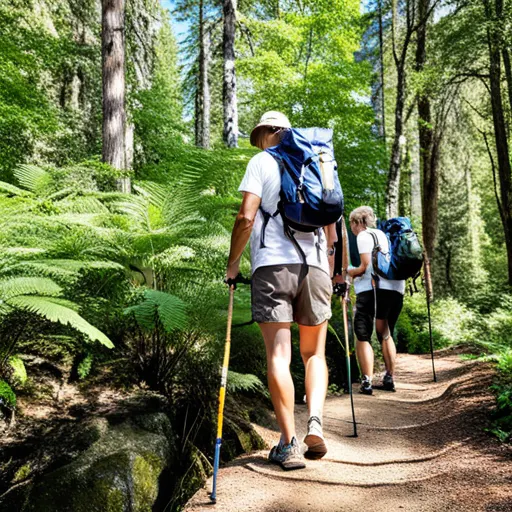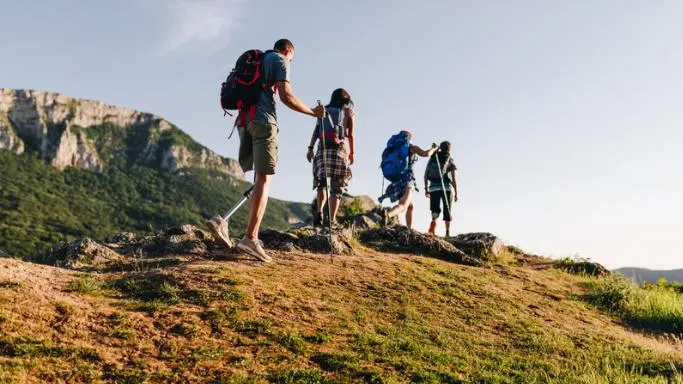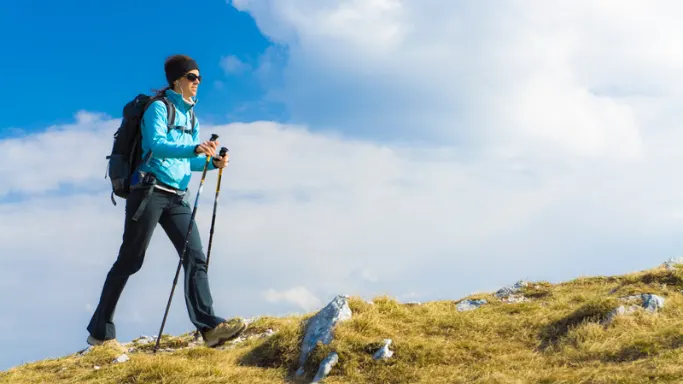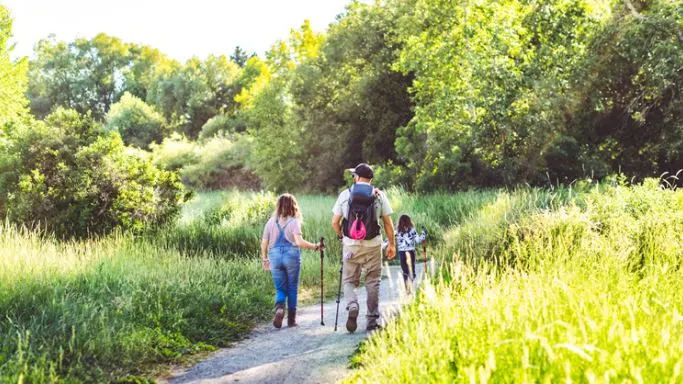Trekking poles: Are they really worth it?
How to Tie Hiking Pole to Backpack: I used to think that trekking poles were just for old people and people with bad knees. But after using them on a few hikes, I was a convert. Trekking poles are a great piece of gear for any hiker, regardless of age or fitness level.

Here are just a few of the benefits of using trekking poles:
- Maintaining balance on uneven terrain: Trekking poles can help you maintain your balance on uneven terrain by providing a third point of contact with the ground. This is especially important on trails with rocks, roots, or loose soil, where it can be easy to lose your footing. Trekking poles can also help you balance when you’re going uphill or downhill, or when you’re crossing a stream.
- Reducing impact on your knees: When you hike, your knees absorb a lot of impact. This can be especially hard on your knees if you’re carrying a heavy backpack or if you’re hiking on uneven terrain. Trekking poles can help reduce the impact on your knees by transferring some of the force to your upper body. This can help prevent knee pain and injuries.
- Hiking more efficiently: Trekking poles can help you hike more efficiently by providing support and propulsion. When you use trekking poles, you can use your arms to help you move forward, which can save your legs energy. This can help you hike longer distances and faster speeds.
- Staying comfortable on long hikes: Trekking poles can help you stay comfortable on long hikes by reducing fatigue in your arms and shoulders. When you use trekking poles, you can use your arms to help you balance and propel yourself forward. This can help reduce the strain on your legs, which can make your hike more comfortable.

In addition to these benefits, trekking poles can also help you:
- Cross streams more easily
- Climb steep terrain
- Ascend and descend hills more easily
- Stay upright in strong winds
- Signal for help in an emergency
If you’re thinking about getting into hiking, I highly recommend giving trekking poles a try. They might just change the way you hike!
What are you waiting for? Keep reading to learn more about the benefits of trekking poles and how to choose the right pair for you.

In this article, we’ll cover:
- The different types of trekking pole attachment systems.
- How to choose the right attachment system for your backpack.
- Instructions on how to use the different attachment systems.
- Tips for securing your trekking poles to your backpack.
So whether you’re a seasoned hiker or just getting started, this article is for you. We’ll cover everything you need to know about trekking poles, so you can hit the trail feeling confident and prepared.
Let’s get started with;
The different types of trekking pole attachment systems
There are a few different types of trekking pole attachment systems, and each one has its own advantages and disadvantages. Here’s a rundown of the three most common types:
Built-in attachment points: These are the most common type of trekking pole attachment system. They’re built into the backpack, and they typically consist of two loops or straps that are located on the shoulder straps.
The advantage of built-in attachment points is that they’re very secure. The poles are held in place by the loops or straps, and they’re less likely to come loose. This is especially important if you’re hiking on uneven terrain or in windy conditions.
The disadvantage of built-in attachment points is that they can be difficult to adjust. If you have a backpack with a lot of padding, it can be difficult to get the poles to fit properly.
Daisy chains: Daisy chains are a type of webbing that is sewn onto the backpack. They’re typically located on the shoulder straps, the hip belt, or both.
The advantage of daisy chains is that they’re very versatile. You can use them to attach a variety of gear, including trekking poles, water bottles, and cameras. This is great if you like to carry a lot of gear with you on your hikes.

The disadvantage of daisy chains is that they can be bulky. If you have a lot of gear attached to your backpack, it can be difficult to move around comfortably.
External straps: External straps are straps that are attached to the outside of the backpack. They’re typically located on the shoulder straps, the hip belt, or both.
The advantage of external straps is that they’re very easy to adjust. You can tighten or loosen the straps to get a perfect fit. This is great if you’re hiking in different types of terrain and you need to adjust the way your poles are attached to your backpack.
The disadvantage of external straps is that they can be less secure than built-in attachment points or daisy chains. The poles are not held in place as tightly, and they’re more likely to come loose.
So, which type of trekking pole attachment system is right for you? It depends on your individual needs and preferences. If you’re looking for a secure system that is easy to adjust, then built-in attachment points or daisy chains are a good option. If you’re looking for a versatile system that is easy to use, then external straps are a good option.
Ultimately, the best way to decide which type of trekking pole attachment system is right for you is to try out a few different systems and see which one you prefer.

How to choose the right attachment system for your backpack
Choosing the right trekking pole attachment system is important for ensuring that your poles are secure and easy to access when you need them. There are a few factors to consider when making your decision, such as the size and weight of your backpack, the type of trekking poles you use, and your personal preferences.
The size and weight of your backpack:
- If you have a large or heavy backpack, you’ll need a trekking pole attachment system that can accommodate the weight. Built-in attachment points are typically the best option for large or heavy backpacks. This is because they are designed to support the weight of the poles and keep them secure.
- If you have a smaller or lighter backpack, you may be able to get away with using a daisy chain or external straps. However, it’s important to make sure that the system you choose is strong enough to support the weight of the poles.

The type of trekking poles you use:
- If you use telescoping trekking poles, you’ll need a trekking pole attachment system that can accommodate the different lengths of the poles. Daisy chains are typically the best option for telescoping trekking poles. This is because they are adjustable, so you can easily shorten or lengthen the poles to fit the system.
- If you use fixed-length trekking poles, you’ll have more flexibility in terms of the attachment system you choose. You can use a built-in attachment point, daisy chain, or external straps.
Your personal preferences:
- Some people prefer a trekking pole attachment system that is very secure. They want to be sure that their poles are not going to come loose, especially if they are hiking on uneven terrain or in windy conditions. Built-in attachment points are typically the best option for people who want a secure system.
- Other people prefer a trekking pole attachment system that is more versatile. They want to be able to adjust the way their poles are attached to their backpack, depending on the terrain or their needs. Daisy chains or external straps are typically the best options for people who want a versatile system.
Here are some additional tips for choosing a trekking pole attachment system:
Read reviews, When reading reviews, it’s important to pay attention to the following factors:
- The type of backpack the reviewer was using
- The type of trekking poles the reviewer was using
- The reviewer’s personal preferences
- It’s also helpful to read reviews from a variety of sources, such as online retailers, hiking forums, and gear review websites.
Try out different systems:
- If you can, try out different trekking pole attachment systems before you buy one. This is the best way to make sure that you find a system that is comfortable and secure.
- You can try out different systems at outdoor retailers or by borrowing them from friends or family members.
Consider your budget:
- Trekking pole attachment systems can range in price from very affordable to quite expensive. It’s important to set a budget before you start shopping so that you don’t overspend.
- If you’re on a budget, there are still some good options available. However, it’s important to make sure that the system you choose is durable and will last.
Instructions on how to use the different attachment systems
As a hiker, I’ve learned that it’s important to have a secure and comfortable way to carry my trekking poles. Here are step-by-step instructions on how to use the different types of trekking pole attachment systems.
Built-in attachment points:
- Step 1: Locate the built-in attachment points on your backpack. These are typically two loops or straps that are located on the shoulder straps.
- Step 2: Insert the tips of your trekking poles into the loops or straps.
- Step 3: Tighten the straps or loops to secure the poles in place.
Daisy chains:
- Step 1: Locate the daisy chain on your backpack. This is a piece of webbing that is sewn onto the backpack.
- Step 2: Thread the tips of your trekking poles through the daisy chain.
- Step 3: Adjust the daisy chain to secure the poles in place.
External straps:
- Step 1: Locate the external straps on your backpack. These are typically two straps that are attached to the outside of the backpack.
- Step 2: Thread the tips of your trekking poles through the straps.
- Step 3: Tighten the straps to secure the poles in place.
I hope this helps!

Here are some additional tips for using trekking pole attachment systems:
- Make sure that the poles are inserted into the loops or straps securely. You don’t want them to come loose while you’re hiking.
- Adjust the straps or loops so that the poles are comfortable to carry. You don’t want them to be too tight or too loose.
- If you’re using a daisy chain, make sure that the poles are not too close together. You want to be able to easily reach them when you need them.
- If you’re using external straps, make sure that the straps are long enough to accommodate the different lengths of your poles.
10 Tips for securing your trekking poles to your backpack
Here are 10 tips for securing your trekking poles to your backpack:
1. Use a locking carabiner.
A locking carabiner is a great way to secure your trekking poles in your backpack. It’s more secure than a regular carabiner, and it’s also less likely to come undone accidentally.
2. Tie a knot in the straps.
If you don’t have a locking carabiner, you can tie a knot in the straps that hold your trekking poles in place. This will help to keep the poles from coming loose.
3. Use a daisy chain.
A daisy chain is a series of loops that are sewn onto the backpack. You can thread the tips of your trekking poles through the loops to secure them in place.
4. Use external straps.
Some backpacks have external straps that you can use to secure your trekking poles. These straps are typically located on the sides or bottom of the backpack.
5. Make sure the poles are inserted securely.
When you insert the tips of your trekking poles into the loops or straps, make sure that they are inserted securely. You don’t want them to come loose while you’re hiking.
6. Adjust the straps so the poles are comfortable.
The straps or loops that hold your trekking poles in place should be adjusted so that the poles are comfortable to carry. You don’t want them to be too tight or too loose.
7. If you’re using a daisy chain, make sure that the poles are not too close together. You want to be able to easily reach them when you need them.
8. If you’re using external straps, make sure the straps are long enough to accommodate the different lengths of your poles.

9. Check the attachment system regularly.
It’s a good idea to check the attachment system for your trekking poles regularly. Make sure that the poles are still secure and that the straps or loops are not frayed.
10. Practice using the attachment system before you go hiking.
It’s a good idea to practice using the attachment system for your trekking poles before you go hiking. This will help you to make sure that you know how to use it correctly and that you’re comfortable with it.

Additional tips that you may find helpful:
- If you’re hiking in a remote area, you may want to consider using a locking carabiner and tying a knot in the straps as an extra layer of security.
- If you’re using a backpack with a built-in attachment system, make sure that the loops or straps are in good condition. If they’re frayed or damaged, they may not be able to hold the poles securely.
- If you’re using a daisy chain, make sure that the loops are not too close together. You don’t want the poles to get caught on each other or on the backpack.
- If you’re using external straps, make sure that the straps are long enough to accommodate the different lengths of your poles. You don’t want the poles to be too short or too long.
That’s a wrap
If you’re looking to add more comfort to your trek footwear would be the best option, hiking boots are a great choice. They offer more ankle support and protection than Vans, which can be important for long hikes or on rough terrain. For more information on the pros and cons of Vans for hiking, check out my article “Are Vans Any Good?”.
In this article, we covered the basics of trekking pole attachment systems. We talked about the different types of systems, how to choose the right system for your backpack, and how to use the different systems. We also provided some tips for securing your trekking poles in your backpack.

I hope this article has been helpful. If you have any further questions, please feel free to reach out to me. I’m always happy to help!
And be sure to check out our other articles on hiking. We’ve got a lot of great content on gear, trails, and everything in between.
We also encourage you to share this article with your friends and fellow hikers. The more people who know about trekking pole attachment systems, the safer and more enjoyable their hikes will be.
If you’re new to using walking poles, or if you’re looking for a refresher on the proper technique, I recommend checking out this article: ‘How to Use Walking Poles Correctly: A Confident Guide‘. This article provides a comprehensive guide on how to use walking poles correctly, and it covers everything from adjusting the height of your poles to using them for propulsion.
Thanks for reading!
Resources
FAQ
What are the different ways to tie hiking poles to a backpack?
There are three main ways to tie hiking poles to a backpack:
- Built-in attachment points: Many backpacks have built-in attachment points for trekking poles. These are typically two loops or straps that are located on the shoulder straps of the backpack. To attach your trekking poles, simply insert the tips of the poles into the loops or straps and tighten them.
- Daisy chains: A daisy chain is a piece of webbing that is sewn onto the backpack. To attach your trekking poles, simply thread the tips of the poles through the daisy chain and adjust it to secure them in place.
- External straps: Some backpacks have external straps that can be used to attach trekking poles. These straps are typically located on the sides or bottom of the backpack. To attach your trekking poles, simply thread the tips of the poles through the straps and tighten them.
Which method is the best way to tie hiking poles to a backpack?
The best method for tying hiking poles to a backpack depends on the type of backpack you have and your personal preferences. If your backpack has built-in attachment points, then this is the easiest and most secure method. If your backpack does not have built-in attachment points, then you can use a daisy chain or external straps.
How do I tie my trekking poles to my backpack securely?
To tie your trekking poles to your backpack securely, make sure that the tips of the poles are inserted into the loops or straps tightly. If you are using a daisy chain, adjust it so that the poles are snug but not too tight. If you are using external straps, make sure that the straps are long enough to accommodate the length of your poles.
How often should I check the attachment of my trekking poles to my backpack?
You should check the attachment of your trekking poles to your backpack regularly, especially if you are hiking on uneven terrain or in windy conditions. This will help to ensure that your poles do not come loose and cause you an injury.
